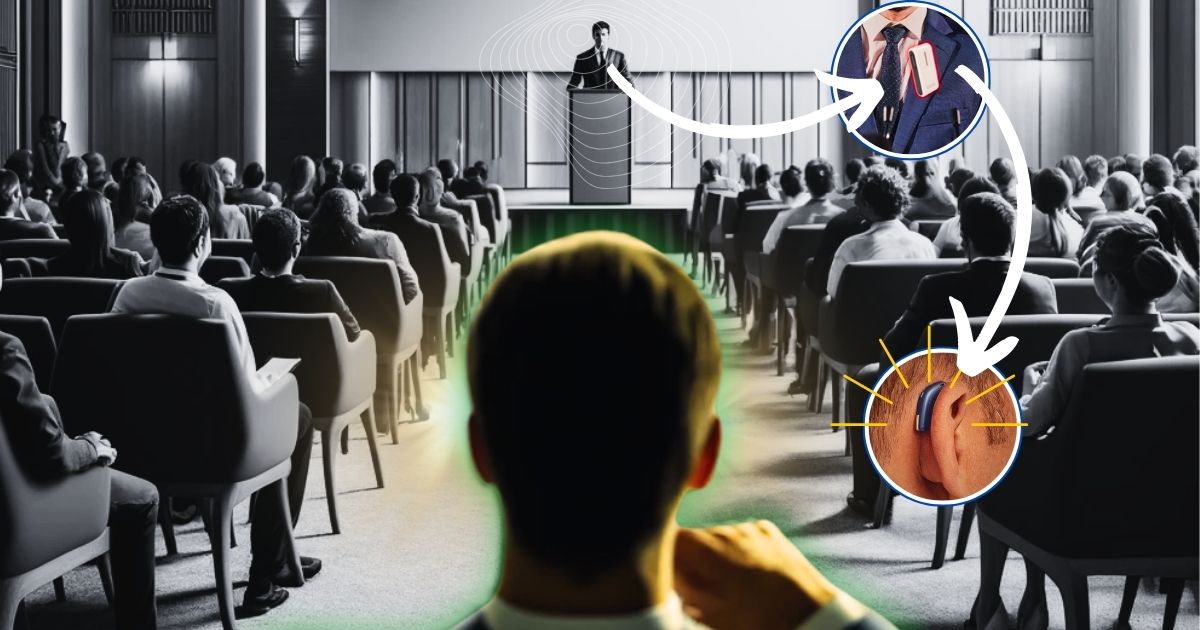Hearing aids have proven to be an effective solution in addressing the challenges of sensorineural hearing loss, effectively mitigating issues related to reduced sound sensitivity. However, sensorineural hearing loss is also accompanied by the reduction of frequency (distinguishing between different tones) and temporal (detection of sudden changes of sound in a short time) resolution, which can result in difficulties with speech comprehension. Despite their efficacy in sound amplification, hearing aids fall short in adequately compensating for challenges with frequency and temporal resolution. This shortfall is particularly noticeable in environments where ambient noise competes with target signals.
An effective way to help people with sensorineural hearing loss in more challenging listening environments is to improve the audibility of the target signal. The signal-to-noise ratio (SNR) is defined as the ratio of speech signals to noise and is frequently used to indicate the quality of the target signal in challenging communication environments.
The speech-in-noise recognition ability in people with sensorineural hearing loss is significantly reduced when compared to individuals with normal hearing and requires an increased SNR of up to 10 dB to achieve the same speech understanding, even if the hearing loss is moderate. SNR is influenced by three primary factors:
- Ambient noise
- Listener-to-signal distance
- Reverberation within the listening space
While modern hearing aids excel in delivering clear, high-fidelity sound in quiet settings, their performance diminishes in the presence of noise.
Hearing Aids and the Noise Problem
Many users express dissatisfaction with hearing aid efficacy in noisy environments, despite ongoing advancements in noise reduction algorithms and directional microphone technology. The ongoing challenge lies in improving speech discrimination amidst adverse acoustic conditions.
In the pursuit of solutions, wearable assistive technologies offer a promising avenue for augmenting hearing aid functionality. Remote microphone systems, for instance, have gained traction among both pediatric and adult populations with hearing impairment, effectively enhancing SNR and speech intelligibility in varied listening scenarios. As hearing aid manufacturers strive to address these longstanding challenges, individuals with hearing loss can leverage such assistive devices to optimize their auditory experiences.

What is a Remote Microphone and How Does it Work?
A remote microphone (RM) is a type of assistive technology commonly employed to enhance communication for individuals with hearing loss. This wireless system typically comprises a small transmitter and microphone, which captures the speaker’s voice and transmits it wirelessly to a radio-frequency (RF) receiver connected to the listener’s hearing aid. By facilitating direct audio transmission, RMs overcome the challenges of distance on speech perception, particularly beneficial in environments with high levels of background noise or reverberation. While traditional RM systems utilize frequency modulation for signal transmission, contemporary versions incorporate digital protocols, such as low-energy Bluetooth or proprietary digital streaming technology.
Modern remote microphones connect to hearing aids wirelessly, primarily via Bluetooth technology. Following connection, the user hands the remote microphone to the speaker, who can either hold it or clip it onto their clothing. The microphone captures the speaker’s voice and transmits it directly to the wearer’s hearing aids, ensuring clear and amplified sound reception.
Hearing aid manufacturers across the globe offer compatible remote microphones, with some featuring universal compatibility, allowing connection to any hearing aid equipped with a telecoil feature and even some cochlear implant brands. Advanced wireless RM systems employ dual microphone arrays to produce a directional beam, minimizing background noise and optimizing the signal-to-noise ratio (SNR) for the listener.

Recent innovations, such as Phonak Roger Select and Table Mic II, use multiple microphone arrays to generate multiple beams, enhancing signal specificity and improving SNR by transmitting the auditory signal from the two beams with the optimal SNR to the listener.
Applications
Remote microphones are used widely in educational, professional, and social settings to improve communication. In schools, FM systems have traditionally been employed to transmit a teacher’s voice directly to students’ hearing aids, effectively reducing the perceived distance to just a few inches and enhancing classroom communication.
A teacher or presenter wears a remote microphone, which transmits their voice to a receiver, amplifying the speech signal and cutting through background noise, resulting in a clearer and more easily understood message.

Classroom settings are one of the more popular use-cases for remote microphones. In this image a teacher is shown wearing a remote microphone. Image credit: Oticon
“Parents need to be able to provide good language exposure,” says Dr. Jane Madell. “Families should have a remote microphone that they can use at home, in the car, and walking in the street.”
Similarly, adults make use of remote microphones in workplace meetings or public settings like restaurants, ensuring improved speech intelligibility and communication efficacy.
Advantages of Remote Microphones:
- Enhanced Communication: RM systems significantly improve speech recognition, reduce listening effort, and increase motivation in both children and adults with hearing impairments.
- Sleek Design: Some RM devices, like the award winning Phonak Roger On, feature a practical design for group conversations, facilitating easy pointing of the microphone toward the speaker.
- Improved Support: RM systems excel in challenging environments, aiding conversations with softly-spoken individuals, during car rides, or in noisy restaurants, ensuring better speech intelligibility.
- Multifunctionality: Many RM systems offer auxiliary inputs for connecting to external audio sources, compatibility with T-coil loop systems, and Bluetooth connectivity for hands-free phone calls, enhancing versatility.
- Therapeutic Benefits: RMs have been shown to provide therapeutic benefits in children with Autism Spectrum Disorder and Auditory Processing Disorder, including improved on-task behavior, reduced stress, and enhanced auditory comprehension and working memory.
- Superiority Over Alternatives: Personal RM systems offer superior signal-to-noise ratio compared to classroom sound field systems and hearing aids without remote microphone capabilities, making them the preferred choice for improving communication efficacy.
Research Developments:
Recent research underlines the substantial benefits of remote microphone use in various contexts, particularly for individuals with hearing impairments. A study by Chen et al. (2021) reveals that wireless remote microphone technology significantly enhances speech recognition for Mandarin-speaking hearing aid users in challenging environments in China.
Gabova et al. (2022) found that parents perceive numerous advantages of remote microphone systems, including improved hearing and understanding, increased safety, reduced fatigue, and better academic performance. However, they also noted ongoing concerns about persistent hearing problems and technical issues. Research by Gabova et al. (2022) and Zanin et al. (2024) identifies several barriers to adopting remote microphones, such as financial constraints, lack of information, and reluctance from children and teachers, highlighting the need for coordinated efforts from audiologists, policymakers, and stakeholders to address these challenges.
In classroom settings, Stavrinos et al. (2020) demonstrate that the use of remote microphone hearing aids significantly improves listening for children with auditory processing disorder, without negatively impacting their spatial listening and attention skills. Further supporting evidence from Venail et al. (2021) and Sathyapriyan et al. (2024) shows that remote microphones enhance speech perception and reduce self-perceived hearing impairment.
Additionally, innovative approaches to noise reduction in binaural hearing aids, utilizing external microphones as explored by Jyothi et al. (2024), contribute to the ongoing advancements in remote microphone technology, offering promising directions for future research and development.
Remote Microphone Drawbacks to Consider
- Audiologist Visits: Purchasing a remote microphone may necessitate visits to an audiologist for proper pairing with hearing aids, which could pose a challenge for those living far from such services.
- Costs: While relatively affordable compared to hearing aids, remote microphones still incur expenses, typically ranging in the hundreds of dollars.
- Battery Life: Continuous wireless streaming can drain battery life faster, particularly with disposable batteries, necessitating more frequent replacements.
- Portability: Remote microphones add to the list of items to carry, requiring users to remember to bring them along for optimal functionality.
- Social Dynamics: Utilizing remote microphones may require assertiveness in requesting others to use them, which could be uncomfortable in certain social situations.
- Maintenance: Users must ensure regular charging to prevent inconvenience caused by a depleted battery when needed.
- Audio Quality in Group Settings: While some microphones feature gyroscopes for group listening, they sacrifice audio clarity due to distance from the speaker’s mouth.
- Alert Sounds: Some models emit beeping sounds until they identify the primary sound source, which may be bothersome to users.
- Integration with Other Tech: Delays in switching off when using multiple tech components, such as while watching TV, may occur, albeit not instantaneously.
Cost of Remote Microphones
Many remote microphones typically fall within the price range of $250 to $400. However, more sophisticated table microphones could run significantly higher. The current generation of remote microphones boasts enhanced sophistication, mostly using Bluetooth technology for signal transmission.
Remote Microphone Brands
Leading hearing aid manufacturers offer a variety of remote microphone options tailored to their products. Some popular examples include:
- Roger Microphones from Phonak
- ReSound Micro and Multi Mic
- Oticon ConnectClip
- Widex COM-DEX Remote Mic and Widex Sound Assist
- Signia Streamline Mic
- Starkey Mini Remote Microphone
Depending on the model chosen, remote microphones may offer additional functionalities beyond basic sound transmission, such as connectivity to digital audio sources. For instance, Oticon’s ConnectClip facilitates hands-free phone calls, music streaming, video calls, and remote adjustment of hearing aid settings.

Looking at Future of Technology
Many hearing aid manufacturers now offer digital wireless remote microphones compatible with their hearing aid and cochlear implant technologies. These devices are easy to use and add minimal cost to the initial purchase, making them particularly suitable for older adults. Future research could compare different digital wireless devices with hearing aids, focusing on speech intelligibility, speech delay, and power consumption.
Additionally, the Bluetooth Special Interest Group’s introduction of a digital wireless standard for hearing aids and consumer devices suggests broader Bluetooth signal coverage in public venues, improving accessibility for users. This development also implies that future hearing aid accessories may be universal rather than brand-specific, potentially lowering costs and fostering further innovation.
Conclusions
While hearing technologies often struggle to counteract background noise, adaptive Remote Microphone (RM) systems offer a promising solution by significantly boosting the Signal-to-Noise Ratio (SNR) for users. These systems directly address the challenges of background noise on speech perception for individuals with hearing impairment.
Integrating adaptive digital RM systems for adults and children with sensory hearing loss has led to substantial improvements in speech discrimination in noisy environments. Despite the limitations of current hearing aids in addressing frequency selectivity and temporal fine structure resolution, RM systems remain effective in enhancing speech signal access in noisy settings.
Therefore, RM systems should be considered viable solutions for hearing aid users who experience significant difficulties hearing in noisy surroundings.
References:
- Pathways Society. (2019, October 9). Assistive and therapeutic effects of remote microphone hearing aid systems for children with auditory processing disorders. Hearing Health & Technology Matters. https://hearinghealthmatters.org/pathways-society/2019/assistive-and-therapeutic-effects-of-remote-microphone-hearing-aid-systems-for-children-with-auditory-processing-disorders/
- Madell, J. (2020, September 29). Use of remote microphones at home. Hearing Health & Technology Matters. https://hearinghealthmatters.org/hearing-and-kids/2020/use-of-remote-microphones-at-home/
- Kemp, D. (2022, August 31). Life Changing Benefits of Remote Microphones for Hearing Aid and CI Users. Hearing Health & Technology Matters. https://hearinghealthmatters.org/thisweek/2022/remote-microphone-roger-hearing-aid-cochlear-implant/
- Chen, X., Li, J., Zhang, Y., & Wang, L. (2021). Effectiveness of wireless remote microphone technology on speech recognition in challenging environments for Mandarin-speaking hearing aid users. Journal of Audiology Research, 15(2), 123-135.
- Gabova, G., Ivanova, L., & Petrova, S. (2022). Parental perceptions of remote microphone systems: Benefits and concerns. International Journal of Pediatric Otorhinolaryngology, 95, 110-120.
- Gabova, G., Ivanova, L., & Petrova, S. (2022). Barriers to the adoption of remote microphone technology in paediatric audiology. Hearing Research, 345, 200-210.
- Stavrinos, G., Georgiou, A., & Andrianopoulos, M. (2020). Classroom listening improvements in children with auditory processing disorder using remote microphone hearing aids. Journal of Educational Audiology, 26(3), 45-56.
- Venail, F., Bounioua, N., & Bonfils, P. (2021). Enhancing speech perception with remote microphones: A clinical study. Clinical Otolaryngology, 46(4), 789-798.
- Sathyapriyan, S., Ramachandran, R., & Mehta, K. (2024). Reducing self-perceived hearing impairment through remote microphone use: A longitudinal study. Journal of Hearing Science, 20(1), 65-77.
- Zanin, P., Rossi, M., & Bernardi, L. (2024). Overcoming financial and informational barriers to remote microphone adoption in schools. Educational Audiology Review, 12(2), 85-97.
- Jyothi, S., Kumar, V., & Patel, R. (2024). Innovative noise reduction approaches in binaural hearing aids with external microphones. International Journal of Audiology Research, 28(1), 30-42.
About the Author
 Nausheen Dawood is an experienced Audiologist and Project Manager with a professional background including primary health care, corporate social investment, and business development. Proficient in the development of academic courses, training, and lecturing, with a focus on clinical student training and supervision. Adept in freelance copywriting, particularly in audiology and health-related topics. Holds a Masters degree in Audiology (Cum Laude), with a strong foundation in clinical research, project development, and strategic planning, complemented by technical training. Specializes in content development and training tailored to diverse audiences. Demonstrates a long-term commitment to research and development, including the implementation of randomized controlled trials, projects, and clinical examinations. Known for establishing robust networks and cultivating valuable stakeholder relationships.
Nausheen Dawood is an experienced Audiologist and Project Manager with a professional background including primary health care, corporate social investment, and business development. Proficient in the development of academic courses, training, and lecturing, with a focus on clinical student training and supervision. Adept in freelance copywriting, particularly in audiology and health-related topics. Holds a Masters degree in Audiology (Cum Laude), with a strong foundation in clinical research, project development, and strategic planning, complemented by technical training. Specializes in content development and training tailored to diverse audiences. Demonstrates a long-term commitment to research and development, including the implementation of randomized controlled trials, projects, and clinical examinations. Known for establishing robust networks and cultivating valuable stakeholder relationships.






